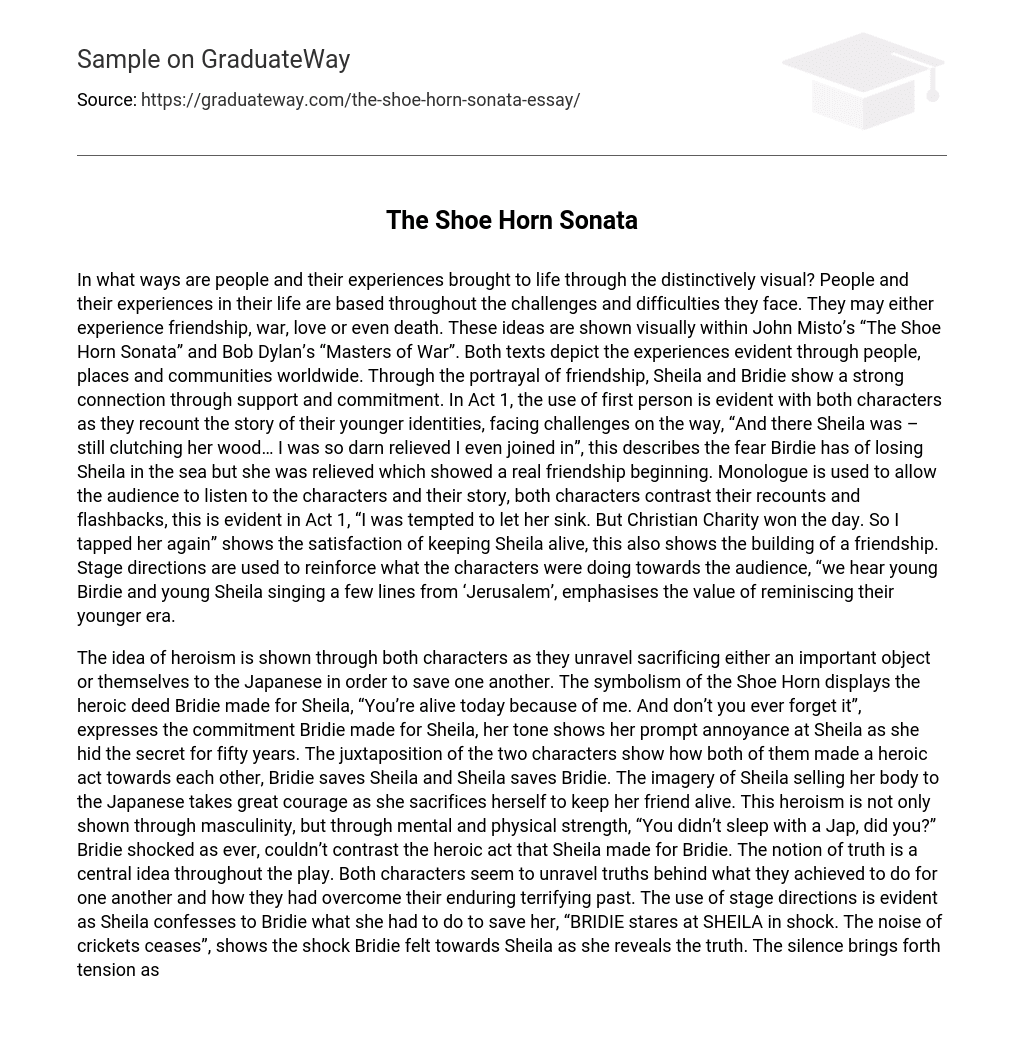In what ways are people and their experiences brought to life through the distinctively visual? People and their experiences in their life are based throughout the challenges and difficulties they face. They may either experience friendship, war, love or even death. These ideas are shown visually within John Misto’s “The Shoe Horn Sonata” and Bob Dylan’s “Masters of War”. Both texts depict the experiences evident through people, places and communities worldwide. Through the portrayal of friendship, Sheila and Bridie show a strong connection through support and commitment. In Act 1, the use of first person is evident with both characters as they recount the story of their younger identities, facing challenges on the way, “And there Sheila was – still clutching her wood… I was so darn relieved I even joined in”, this describes the fear Birdie has of losing Sheila in the sea but she was relieved which showed a real friendship beginning. Monologue is used to allow the audience to listen to the characters and their story, both characters contrast their recounts and flashbacks, this is evident in Act 1, “I was tempted to let her sink. But Christian Charity won the day. So I tapped her again” shows the satisfaction of keeping Sheila alive, this also shows the building of a friendship. Stage directions are used to reinforce what the characters were doing towards the audience, “we hear young Birdie and young Sheila singing a few lines from ‘Jerusalem’, emphasises the value of reminiscing their younger era.
The idea of heroism is shown through both characters as they unravel sacrificing either an important object or themselves to the Japanese in order to save one another. The symbolism of the Shoe Horn displays the heroic deed Bridie made for Sheila, “You’re alive today because of me. And don’t you ever forget it”, expresses the commitment Bridie made for Sheila, her tone shows her prompt annoyance at Sheila as she hid the secret for fifty years. The juxtaposition of the two characters show how both of them made a heroic act towards each other, Bridie saves Sheila and Sheila saves Bridie. The imagery of Sheila selling her body to the Japanese takes great courage as she sacrifices herself to keep her friend alive. This heroism is not only shown through masculinity, but through mental and physical strength, “You didn’t sleep with a Jap, did you?” Bridie shocked as ever, couldn’t contrast the heroic act that Sheila made for Bridie. The notion of truth is a central idea throughout the play. Both characters seem to unravel truths behind what they achieved to do for one another and how they had overcome their enduring terrifying past. The use of stage directions is evident as Sheila confesses to Bridie what she had to do to save her, “BRIDIE stares at SHEILA in shock. The noise of crickets ceases”, shows the shock Bridie felt towards Sheila as she reveals the truth. The silence brings forth tension as neither of them says a word. Humour is seen at the end of the play where Sheila and Bridie take a last dance together as they were young once again, “You distinctively said if the war ever ended, you and I would go dancing” this emphasises the truthful humour brought upon the characters as they waltz together.
The concept of war is shown through a strong sense of the encounters in war and how the “Masters of War” should be put to shame. The first verse depicts the reference to the ‘armchair generals’ and Bob disapproves of their selfish ways by acting in a cowardly manner. This in contrast with the Japanese soldiers and how they treated the innocent prisoners of war with disrespect and pity, in the 2nd verse, the use of rhymes are to reinforce the words he is trying to say, “but built to destroy… like it’s your little toy”, displays the generals making the toys as soldiers which shows no empathy, he plays on to be as if it’s a game, he doesn’t care for the loss of lives. The repetition of “you” is to emphasise the target at the generals being dissed, “you put a gun in my hand…you hide from my eyes…you turn and run faster”, describes the fear generals have and they hide behind the real men facing the atrocities at war. Death is seen through the lyrics as the men at war die in vain for their people, Dylan expresses his feelings for the loss as opposed his hatred for the armchair generals. In the 4th verse, “Then you set back and watch, when the death count gets higher” illustrates the evil and uncared mentality of the generals as they sit back and do nothing about the ceased young soldiers. in the 7th verse, the use of rhetorical questions are shown to reinforce against the generals to make them feel empathy as they spend their worthless money on themselves, “Is your money that good…will it buy you forgiveness…”.The use of imagery displays a sense of death within the song, “And I hope that you die…I will follow your casket… I’ll watch while you’re lowered”, illustrates the hatred Dylan feels towards the Generals as they should be good at one thing, being dead. This is also evident with the Japanese as the prisoners of war want the Japanese soldiers to die a painful death as they treated the prisoners fearfully. To conclude, these two texts portray the importance of friendship, trust and heroism as well as the atrocities at war which led to death. These two texts explored the grief and hell within being a prisoner and a survivor.





